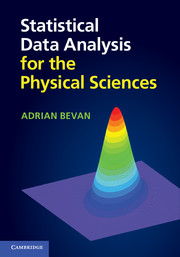Book contents
- Frontmatter
- Contents
- Preface
- 1 Introduction
- 2 Sets
- 3 Probability
- 4 Visualising and quantifying the properties of data
- 5 Useful distributions
- 6 Uncertainty and errors
- 7 Confidence intervals
- 8 Hypothesis testing
- 9 Fitting
- 10 Multivariate analysis
- Appendix A Glossary
- Appendix B Probability density functions
- Appendix C Numerical integration methods
- Appendix D Solutions
- Appendix E Reference tables
- References
- Index
1 - Introduction
Published online by Cambridge University Press: 05 July 2013
- Frontmatter
- Contents
- Preface
- 1 Introduction
- 2 Sets
- 3 Probability
- 4 Visualising and quantifying the properties of data
- 5 Useful distributions
- 6 Uncertainty and errors
- 7 Confidence intervals
- 8 Hypothesis testing
- 9 Fitting
- 10 Multivariate analysis
- Appendix A Glossary
- Appendix B Probability density functions
- Appendix C Numerical integration methods
- Appendix D Solutions
- Appendix E Reference tables
- References
- Index
Summary
The use of statistical data analysis in physics means different things to different people. The reason for this is that most problems are different, and so someone concentrating on areas where the experimental data collected are relatively straightforward to analyse will naturally tend to use techniques that are simpler than those required for a more complicated problem or for a sparse data sample. Ultimately we all need to use statistical methods in order to translate data into some measure of a physical observable. This book will discuss a number of different concepts and techniques in order of increasing complexity. Before embarking on a discussion of statistics the remainder of this chapter introduces three common experimental problems encountered by students studying physics: (i) using a pendulum to measure acceleration due to gravity (Section 1.1), (ii) testing the validity of Ohm's law for a conductor (Section 1.2), and (iii) measuring the half-life of a radioactive isotope (Section 1.3). These examples rely on material covered in Chapters 4 through 7 and Chapter 9. Readers who appreciate the context of material in the remainder of this book may wish to skip forward to the next chapter.
- Type
- Chapter
- Information
- Statistical Data Analysis for the Physical Sciences , pp. 1 - 11Publisher: Cambridge University PressPrint publication year: 2013
- 1
- Cited by



